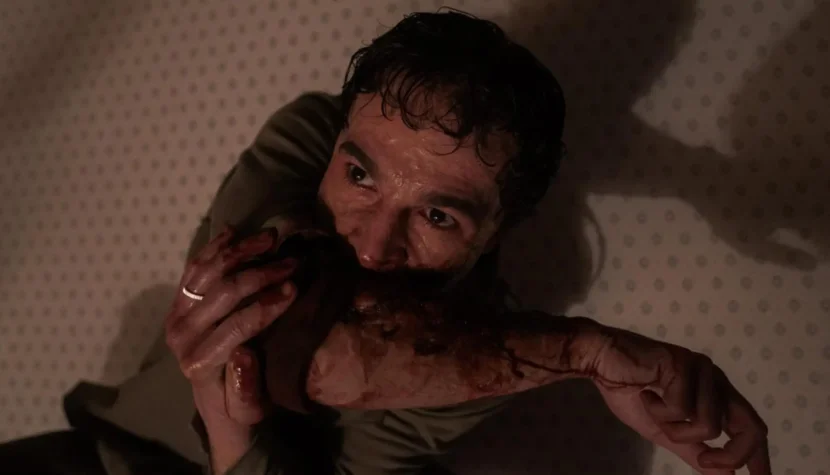WOLF MAN. Big Bad Wolf [REVIEW]

“Goslings, goslings, come home – we’re scared.” “Of what?” “The big bad wolf!” This is the start of a famous playground game. Similarly, in the fairy tale of The Three Little Pigs, the wolf, when denied entry to the animals’ homes, utters the ominous threat: “Let me in, or I’ll get angry. Then I’ll huff, and I’ll puff, and I’ll blow your house down.” Why is it that this particular animal is so universally vilified in the collective imagination? Why is it always perceived as a threat to family safety? Without a doubt, the wolf in popular culture embodies fear of the outside world. As we begin 2025, this fear resurfaces in a film aptly titled Wolf Man. The premise may remind one of Grimms’ fairy tales: a couple and their child lose their peace and sense of security after encountering an outsider—in this case, a werewolf.
The same motif has haunted mass audiences countless times before. At the helm of this horror is undoubtedly a talented creator—Leigh Whannell—chosen by Blumhouse Studios to craft a loosely interconnected universe based on Universal’s classic monsters. So… why didn’t it work this time? Let’s reflect.
To highlight the flaws of Wolf Man, we need only consider what worked in Leigh Whannell’s previous films and compare how those elements fare in this context:
1. Color Palette
In Whannell’s earlier works, the color palette was distinctive and functional, complementing the narrative. Here? It’s weak. The werewolf’s point-of-view shots, heavily edited in post-production, are a nightmare—a stylistic dead end. It’s hard to believe that Whannell, who so masterfully used subjective storytelling in Upgrade, opted for such a sloppy visual approach. The drab, murky darkness dominates the screen, eroding not only the film’s meaning but even the viewer’s enjoyment.

2. Cinematography
In Upgrade, the director went to great lengths to portray the protagonist’s unusual circumstances. How do you convey his extreme, chaotic state? The solution was bold, experimental camerawork that matched the character’s mechanical reactions. In Wolf Man, a similar approach is attempted only sporadically. Sometimes the camera tilts with the werewolf, or slowly flips the image upside down—but it lacks the youthful energy and intentionality that gave Whannell’s earlier work its punch. These techniques feel more like half-hearted gestures than deliberate storytelling choices.
3. Subtext and Metaphor
In The Invisible Man, what did the titular monster represent? It was a clear symbol of trauma from an abusive relationship. The protagonist’s tumultuous breakup echoes through her life, leaving her with the chilling sense of being watched by an invisible predator. This time, five years later, lycanthropy is meant to symbolize unresolved paternal struggles. When it seems like these issues have been addressed, they “infect” the next generation. It’s an intriguing concept, but Whannell fumbles it. The emotional resonance is lost amid the action scenes, which feel disengaged and superficial. By this stage—likely after many rewrites of the original script—Whannell seems less invested in the story than he was at the outset. Somewhere along the way, the project lost its spark.

4. Suspense and Tension
In The Invisible Man, every subtle camera pan heightened the viewer’s anticipation of the worst. It was a taut film that made excellent use of its runtime. In Wolf Man, Whannell struggles with pacing. The story takes forever to get going, and once it does, it oscillates between rushed and sluggish. The film skimps on genuinely engaging, relatively original scenes, instead stretching out sequences that are either narratively pointless or visually uninspired. The finale, devoid of a strong concept, risks losing the audience’s attention entirely.
Interestingly, Wolf Man has more in common with the reimagined original from 1941 than one might expect. The story’s foundation lies in familial trauma: a man, trying to protect his loved ones from a werewolf, becomes a danger to them himself. While this premise is compelling on paper, in practice it leaves the audience cold. Whannell, with his one-dimensional characters, loses his way in the gloomy forest. He inadvertently surrenders control over the narrative. Where the original struck a balance between eeriness and entertainment, Wolf Man takes itself far too seriously. It shuns camp and kitsch—an odd choice given the playful undertones of The Invisible Man. What remains is a grim tale of unresolved childhood trauma. Without a counterbalance to this heavy-handed drama, the film becomes tedious.

The movie also attempts to echo other horror classics, most notably Stanley Kubrick’s The Shining. Similarly, a three-person family is isolated in a remote location. Similarly, the father descends into madness. Even the finale is conceptually alike. One of the opening scenes in Wolf Man—a bird’s-eye view of a car winding through a forest—feels like a direct nod to Kubrick’s masterpiece. While the inspirations are admirable, they come across as faint echoes of that cinematic milestone.
In my opinion, the blame for the film’s failure lies equally with the director and the studio. Time also played a role. A few years ago, this project had different screenwriters, and Ryan Gosling was the name most associated with it. Much has changed since then. What we’re left with is a mediocre product, rushed to meet a promise, with everyone eager to move on to other horror projects.
That said, this stumble doesn’t strip Whannell of his title as a skilled director. He saw the project through to completion, even if the result is underwhelming and forgettable. Oh well. We’ll wait for Blumhouse’s next horror offerings. The studio has accustomed us to a certain ebb and flow of quality. Disappointments are often followed by pleasant surprises. Let’s hope this time is no different.

